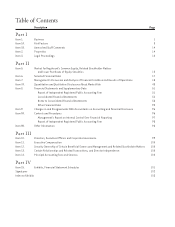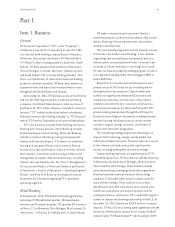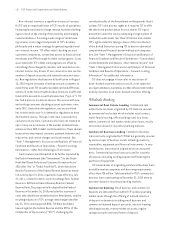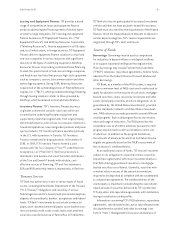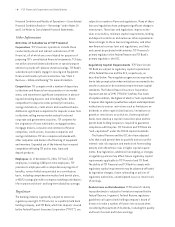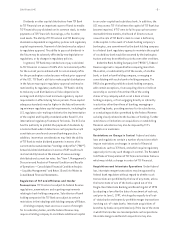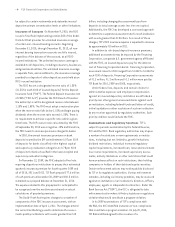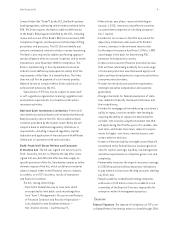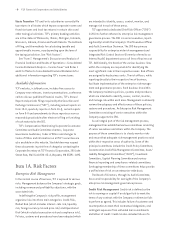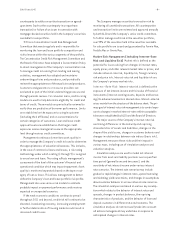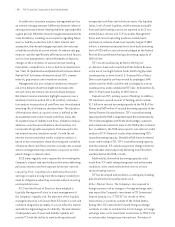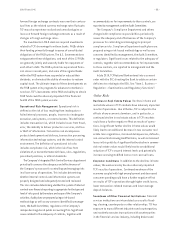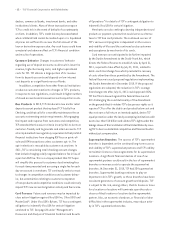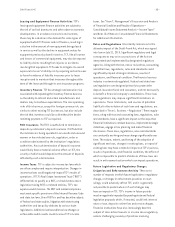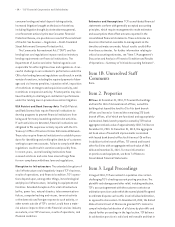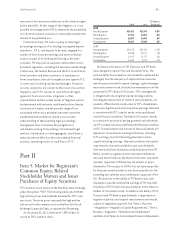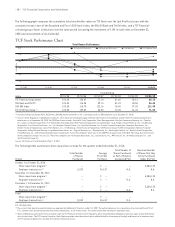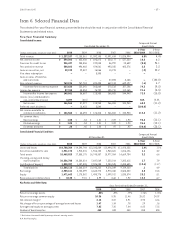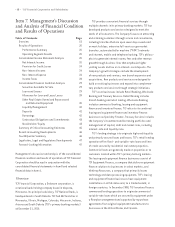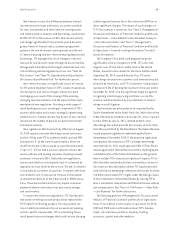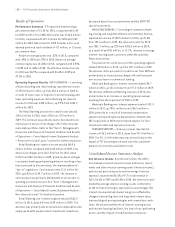TCF Bank 2010 Annual Report Download - page 26
Download and view the complete annual report
Please find page 26 of the 2010 TCF Bank annual report below. You can navigate through the pages in the report by either clicking on the pages listed below, or by using the keyword search tool below to find specific information within the annual report.• 10 • TCF Financial Corporation and Subsidiaries
In addition to valuation analyses, management utilizes
an interest rate gap measure (difference between interest-
earning assets and interest-bearing liabilities repricing within
a given period). While the interest rate gap measurement has
some limitations, including no assumptions regarding future
asset or liability production and a static interest rate
assumption, the interest rate gap represents the net asset
or liability sensitivity at a point in time. An interest rate gap
measure could be significantly affected by external factors
such as loan prepayments, early withdrawals of deposits,
changes in the correlation of various interest-bearing
instruments, competition or a rise or decline in interest rates.
See “Item 7A. Quantitative and Qualitative Disclosures About
Market Risk” for further information about TCF’s interest-
rate risk, gap analysis and simulation analyses.
Management also uses valuation analyses to measure
risk in the balance sheet that might not be taken into
account in the net interest income simulation analyses.
Net interest income simulation highlights exposure over a
relatively short time period (12 or 24 months), and valua-
tion analysis incorporates all cash flows over the estimated
remaining life of all balance sheet positions. The valuation
of the balance sheet, at a point in time, is defined as the
discounted present value of asset cash flows minus the
discounted value of liability cash flows. Valuation analysis
addresses only the current balance sheet and does not
incorporate the growth assumptions that are used in the
net interest income simulation model. As with the net
interest income simulation model, valuation analysis is
based on key assumptions about the timing and variability
of balance sheet cash flows and does not take into account
actions management may undertake in response to antici-
pated changes in interest rates.
ALCO meets regularly and is responsible for reviewing the
Company’s interest rate sensitivity position and establishing
policies to monitor and limit exposure to interest-rate risk.
Liquidity Risk Liquidity risk is defined as the risk to
earnings or capital arising from the Company’s inability to
meet its obligations when they come due without incurring
unacceptable losses.
ALCO and the Board of Directors have adopted a
Liquidity Management Policy to direct management of
the Company’s liquidity risk. The objective of the liquidity
management policy is to ensure that TCF meets its cash and
collateral obligations promptly, in a cost-effective manner
and with the highest degree of reliability. The maintenance
of adequate levels of asset and liability liquidity will
provide TCF with the ability to meet both expected and
unexpected cash flows and collateral needs. Key liquidity
ratios, level of asset liquidity, and the amount available
from available funding sources are reported to ALCO on a
monthly basis. At year end, TCF’s Liquidity Management
Policy and current operating practices established a
minimum on-balance sheet asset liquidity target of $350
million, a maximum unsecured short-term daily borrowing
limit of $225 million, and collateral pledged at the Federal
Reserve Discount Window having a borrowing capacity of
$500 million.
TCF’s asset liquidity may be held in the form of
on-balance sheet cash invested with the Federal Reserve
or the use of overnight Federal Funds Sold to highly rated
counterparties or short-term U.S. Treasury Bills or Notes.
Other asset liquidity can be provided by unpledged, AAA
rated securities which could be sold or pledged to various
counterparties under established TCF lines. At December 31,
2010, TCF had asset liquidity of $507 million.
Deposits are TCF’s primary source of funding. In addition,
TCF maintains secured sources of funding, which include
$1.7 billion in secured borrowing capacity at the FHLB of Des
Moines and $529 million of secured borrowing capacity at the
Federal Reserve Discount Window. TCF’s secured borrowing
capacity with the FHLB is dependent upon the maintenance by
TCF of a Borrowing Base Certificate which pledges consumer
and commercial real estate loans to the FHLB under a blanket
lien. In addition, the FHLB relies upon its own internal credit
analysis of TCF’s financial results when determining TCF’s
secured borrowing capacity. Should the FHLB lower its internal
issuer credit rating on TCF, TCF’s secured borrowing capacity
could be reduced, TCF could be required to change collateral
from a blanket lien to physically delivering loan files which
would be held at the FHLB, or both.
Additionally, diminished borrowing capacity could
result from TCF credit rating downgrades and unfavorable
conditions in the credit markets that restrict or limit
various funding sources.
TCF has developed and maintains a contingency funding
plan should certain liquidity needs arise.
Other Market Risks The Company is also exposed to
foreign currency risk as changes in foreign exchange rates
may impact the Company’s investment in TCF Commercial
Finance Canada, Inc. (“TCFCFC”) or results of other
transactions in countries outside of the United States.
During 2010, TCF entered into forward foreign exchange
contracts in order to minimize the risk of changes in foreign
exchange rates on its investment in and loans to TCFCFC and
on certain other foreign lease transactions. The value of


